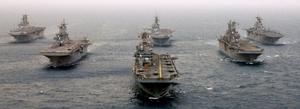In the trenchesBreakthrough in free-electron laser development
Breakthroughs in Free-Electron Laser (FEL) technology could mean a virtually impenetrable defense system for Navy ships; the laser weapon has the capability to detect and engage incoming cruise missiles at the speed of light without running out of ammunition

FEL may make the fleet virtually impregnable // Source: foxnews.com
Breakthroughs in Free-Electron Laser (FEL) technology could mean a virtually impenetrable defense system for Navy ships. The laser weapon in development has the capability to detect and engage incoming cruise missiles at the speed of light without running out of ammunition. The Office of Naval Research (ONR) has been developing the anti-aircraft and missile directed-energy weapon since the 1980s with the goal of creating a megawatt (1 million W) laser weapon with continuous power.
The high-powered FEL uses a superconducting electron gun powered by a microwave tube to emit an intense emission of laser light. Last month, scientists at Los Alamos National lab demonstrated their capability to produce the necessary electrons needed to actuate megawatt laser beams. This development placed its researchers nine months ahead of schedule for its 2011 goals. In a news release, Dinh Nguyen, senior project leader for the Free Electron Laser program at the New Mexico lab said, “Until now, we didn’t have the evidence to support our models.”
Asides from its military applications, FEL has also been employed in the medical field. Research by Dr. Glenn Edwards and colleagues at Vanderbilt University’s FEL center in 1994 found that FEL could be used to excise sensitive tissues like skin, cornea, and brain tissue at wavelengths of approximately 6.45 micrometers. The technology is still being researched and improved upon to minimize and ultimately prevent collateral damage to adjacent tissue.
Quentin Saulter, research program officer at ONR said “the FEL is expected to provide future U.S. Naval forces with a near-instantaneous laser ship defense in any maritime environment throughout the world.” In a video produced by the ONR, Saulter mentions that the project’s workforce consists of experts that specialize in projection, accelerators, electron beam dynamics, and photo-optics.
Sarwat Chappell, research program officer at Air Warfare and Naval Weapons Applications described the FEL as versatile because of its ability to be tuned and generate multiple wavelengths the navy will need when encountering various scenarios across the world.
ONR aims to test the FEL at sea by 2018.
